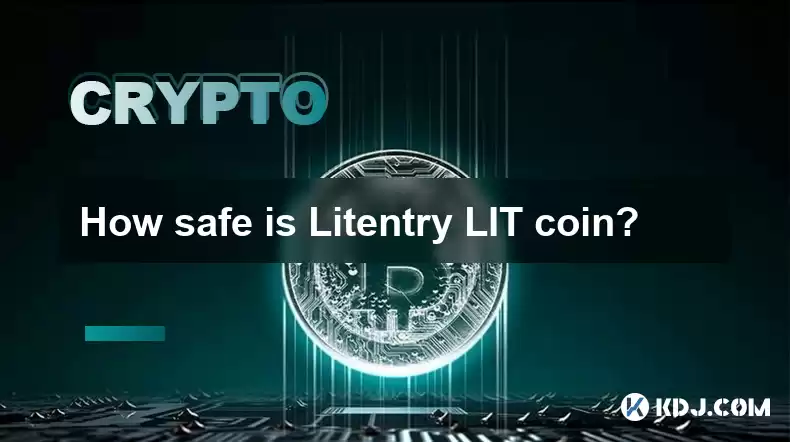-
 Bitcoin
Bitcoin $119300
1.07% -
 Ethereum
Ethereum $3730
3.87% -
 XRP
XRP $3.235
0.29% -
 Tether USDt
Tether USDt $1.000
0.00% -
 BNB
BNB $783.5
1.88% -
 Solana
Solana $188.7
0.25% -
 USDC
USDC $0.0000
-0.01% -
 Dogecoin
Dogecoin $0.2399
-0.44% -
 TRON
TRON $0.3157
2.37% -
 Cardano
Cardano $0.8254
1.94% -
 Hyperliquid
Hyperliquid $42.83
0.14% -
 Stellar
Stellar $0.4372
3.21% -
 Sui
Sui $3.859
4.91% -
 Chainlink
Chainlink $18.53
3.53% -
 Hedera
Hedera $0.2464
0.01% -
 Bitcoin Cash
Bitcoin Cash $519.8
2.46% -
 Avalanche
Avalanche $24.24
2.17% -
 Litecoin
Litecoin $113.7
0.73% -
 UNUS SED LEO
UNUS SED LEO $8.990
0.30% -
 Shiba Inu
Shiba Inu $0.00001390
0.21% -
 Toncoin
Toncoin $3.188
1.49% -
 Ethena USDe
Ethena USDe $1.001
0.02% -
 Polkadot
Polkadot $4.090
-0.91% -
 Uniswap
Uniswap $10.40
4.08% -
 Monero
Monero $326.6
3.12% -
 Bitget Token
Bitget Token $4.627
-0.42% -
 Pepe
Pepe $0.00001281
0.76% -
 Dai
Dai $1.000
0.01% -
 Aave
Aave $291.6
0.98% -
 Cronos
Cronos $0.1269
7.26%
How safe is Litentry LIT coin?
Litentry's decentralized identity verification and multi-signature wallets enhance security, but the platform remains subject to market volatility and potential security vulnerabilities.
Dec 28, 2024 at 12:06 am

Key Points
- Litentry is a blockchain protocol that provides decentralized identity aggregation, management, and verification services.
- LIT is the native utility token of the Litentry network, used for paying transaction fees, staking, and governance.
- Litentry's security measures include Proof-of-Identity, a decentralized identity verification system, and multi-signature wallets.
- However, like any cryptocurrency, Litentry is subject to market volatility and potential security vulnerabilities.
- Investors should conduct thorough research and due diligence before investing in LIT.
Assessing the Safety of Litentry LIT Coin
Blockchain and Consensus Mechanism
- Litentry is built on the Polkadot blockchain, which employs a Proof-of-Stake consensus mechanism.
- Proof-of-Stake secures the network by requiring validators to stake LIT to participate in the consensus process, disincentivizing malicious behavior.
Decentralized Identity Verification
- Litentry's decentralized identity verification system, Proof-of-Identity, allows users to control their identity data and verify it without intermediaries.
- Users can submit their identity credentials to trusted entities, who then issue verifiable claims.
- These claims are stored on the blockchain, providing a secure and transparent way to verify identity.
Multi-Signature Wallets
- Litentry offers multi-signature wallets, which require multiple authorized users to approve transactions.
- This feature increases the security of LIT holdings by preventing unauthorized access and theft.
Staking and Governance
- LIT holders can stake their tokens to participate in network governance and earn rewards.
- Staked LIT is used to secure the network, validate transactions, and cast votes on proposals.
Potential Security Vulnerabilities
- While Litentry implements robust security measures, like any cryptocurrency, it is not immune to security vulnerabilities.
- The platform could be susceptible to hacking attacks, smart contract exploits, and phishing scams.
- Investors should be aware of these risks and take appropriate precautions.
Tips for Safe Usage
- Use strong and unique passwords for your Litentry account.
- Enable two-factor authentication for additional security.
- Store your LIT in a secure hardware wallet or non-custodial wallet.
- Be cautious of phishing emails or websites that request your personal or financial information.
FAQs
Q: How can I protect my LIT from theft?
A: Use multi-signature wallets, store your LIT in a secure hardware wallet, and be aware of potential phishing scams.
Q: Is Litentry safer than other cryptocurrencies?
A: While Litentry has implemented strong security measures, it is subject to the same potential vulnerabilities as any cryptocurrency.
Q: Can I stake my LIT to earn rewards?
A: Yes, LIT holders can stake their tokens to participate in network governance and earn rewards.
Q: How does Litentry's Proof-of-Identity system work?
A: Users can submit their identity credentials to trusted entities, who then issue verifiable claims stored on the blockchain for transparent identity verification.
Q: Are there any risks associated with staking LIT?
A: Staked LIT could be lost if the network is hacked or if the staking platform becomes insolvent.
Disclaimer:info@kdj.com
The information provided is not trading advice. kdj.com does not assume any responsibility for any investments made based on the information provided in this article. Cryptocurrencies are highly volatile and it is highly recommended that you invest with caution after thorough research!
If you believe that the content used on this website infringes your copyright, please contact us immediately (info@kdj.com) and we will delete it promptly.
- NFTs, Trademarks, and Judgments: A New York Minute on the Yuga Labs Case
- 2025-07-25 12:30:11
- Bitcoin, Nativo Resources, and Gold Operations: A New Era for Corporate Treasury
- 2025-07-25 12:50:11
- Bitcoin, Jim Cramer, and the US Deficit: A Wall Street Story
- 2025-07-25 10:30:11
- TGEs, Scalability & Privacy Tech: Decoding the Future of Blockchain
- 2025-07-25 10:30:11
- Crypto Payroll Revolution: How Stablecoins are Changing the Salary Game
- 2025-07-25 12:30:11
- Ben Askren, FUNKY Memecoin, and the Fallout: A New York Minute
- 2025-07-25 10:50:11
Related knowledge

What is Chainlink (LINK)?
Jul 22,2025 at 02:14am
Understanding Chainlink (LINK): The Decentralized Oracle NetworkChainlink is a decentralized oracle network designed to bridge the gap between blockch...

What is Avalanche (AVAX)?
Jul 22,2025 at 08:35am
What is Avalanche (AVAX)?Avalanche (AVAX) is a decentralized, open-source blockchain platform designed to support high-performance decentralized appli...

What is Polkadot (DOT)?
Jul 19,2025 at 06:35pm
Understanding the Basics of Polkadot (DOT)Polkadot (DOT) is a multi-chain network protocol designed to enable different blockchains to transfer messag...

What is Litecoin (LTC)?
Jul 23,2025 at 11:35am
Overview of Litecoin (LTC)Litecoin (LTC) is a peer-to-peer cryptocurrency that was created in 2011 by Charlie Lee, a former Google engineer. It is oft...

What is Monero (XMR)?
Jul 21,2025 at 10:07am
What is Monero (XMR)?Monero (XMR) is a decentralized cryptocurrency designed to provide enhanced privacy and anonymity for its users. Unlike Bitcoin a...

How to add indicators to Ethereum chart on TradingView?
Jul 19,2025 at 07:15am
What Is an Ethereum Chart on TradingView?The Ethereum chart on TradingView is a visual representation of the price movement of Ethereum (ETH) over a s...

What is Chainlink (LINK)?
Jul 22,2025 at 02:14am
Understanding Chainlink (LINK): The Decentralized Oracle NetworkChainlink is a decentralized oracle network designed to bridge the gap between blockch...

What is Avalanche (AVAX)?
Jul 22,2025 at 08:35am
What is Avalanche (AVAX)?Avalanche (AVAX) is a decentralized, open-source blockchain platform designed to support high-performance decentralized appli...

What is Polkadot (DOT)?
Jul 19,2025 at 06:35pm
Understanding the Basics of Polkadot (DOT)Polkadot (DOT) is a multi-chain network protocol designed to enable different blockchains to transfer messag...

What is Litecoin (LTC)?
Jul 23,2025 at 11:35am
Overview of Litecoin (LTC)Litecoin (LTC) is a peer-to-peer cryptocurrency that was created in 2011 by Charlie Lee, a former Google engineer. It is oft...

What is Monero (XMR)?
Jul 21,2025 at 10:07am
What is Monero (XMR)?Monero (XMR) is a decentralized cryptocurrency designed to provide enhanced privacy and anonymity for its users. Unlike Bitcoin a...

How to add indicators to Ethereum chart on TradingView?
Jul 19,2025 at 07:15am
What Is an Ethereum Chart on TradingView?The Ethereum chart on TradingView is a visual representation of the price movement of Ethereum (ETH) over a s...
See all articles

























































































